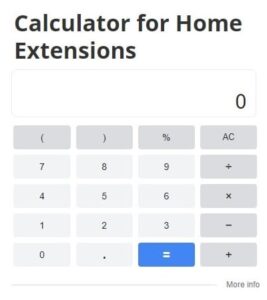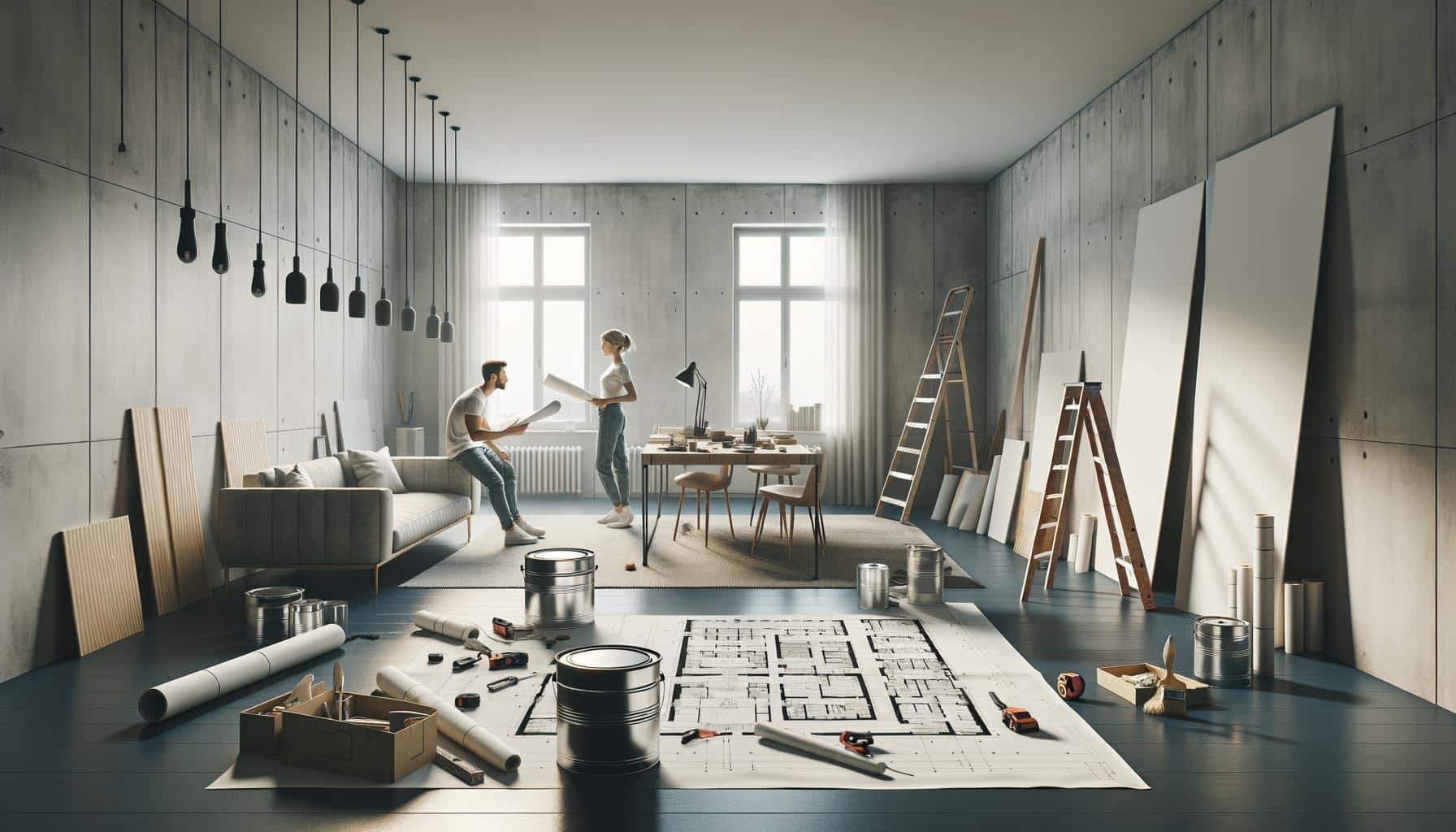
Home renovation costs can be a mystery for many homeowners. At Home Owners Association, we often hear from members wondering how to budget for their dream projects.
This blog post will break down the key factors influencing renovation expenses, provide room-by-room cost estimates, and offer practical tips to help you save money on your next home improvement venture.
What Drives Home Renovation Costs?
Project Scope and Size
The size and scope of your renovation project are primary drivers of cost. A complete home overhaul will cost more than updating a single room. Recent data shows that while the Australian average for home renovations was $63,118, households in Victoria spent on average $71,067, while those in Western Australia spent $54,377. However, this figure can vary widely based on the extent of work. Small bathroom renovations might start at $15,000, while large-scale extensions can exceed $500,000.
Material Quality and Choices
The materials you select play a key role in determining your renovation costs. High-end finishes like marble countertops or custom cabinetry will increase your budget substantially compared to more modest options. Kitchen renovations can range from $25,000 to $50,000, with the choice of cabinetry and benchtops being significant cost factors. Premium materials may cost more upfront, but they often offer better longevity and can enhance your home’s value in the long run.
Labor Costs and Location
Labor typically accounts for a significant portion of total renovation costs, depending on the type of building, complexity of finishes, and location. Recent data shows that hourly rates for tradespeople can vary significantly across Australia. For example, in Western Australia, plumbers charge $45-$50 per hour, electricians $45-$60 per hour, and HVAC technicians $45-$50 per hour. Urban areas typically have higher labor costs than rural regions. You must factor in these regional differences when budgeting for your project.
Unforeseen Issues and Contingencies
Unexpected problems are almost inevitable in renovation projects, especially in older homes. Issues like structural damage, outdated wiring, or asbestos can quickly inflate costs. We recommend setting aside a contingency fund of at least 10-15% of your total budget to cover these unforeseen expenses. This approach can help prevent financial stress and project delays.
The Impact of Timing
The timing of your renovation can also affect costs. Building construction prices rose 0.4% this quarter and 4.3% over the past twelve months, with price growth driven primarily by increased labour costs. This trend suggests that immediate renovations might be more cost-effective. Additionally, completing renovations in one go rather than room by room is advised to save on costs related to multiple visits by tradespeople.
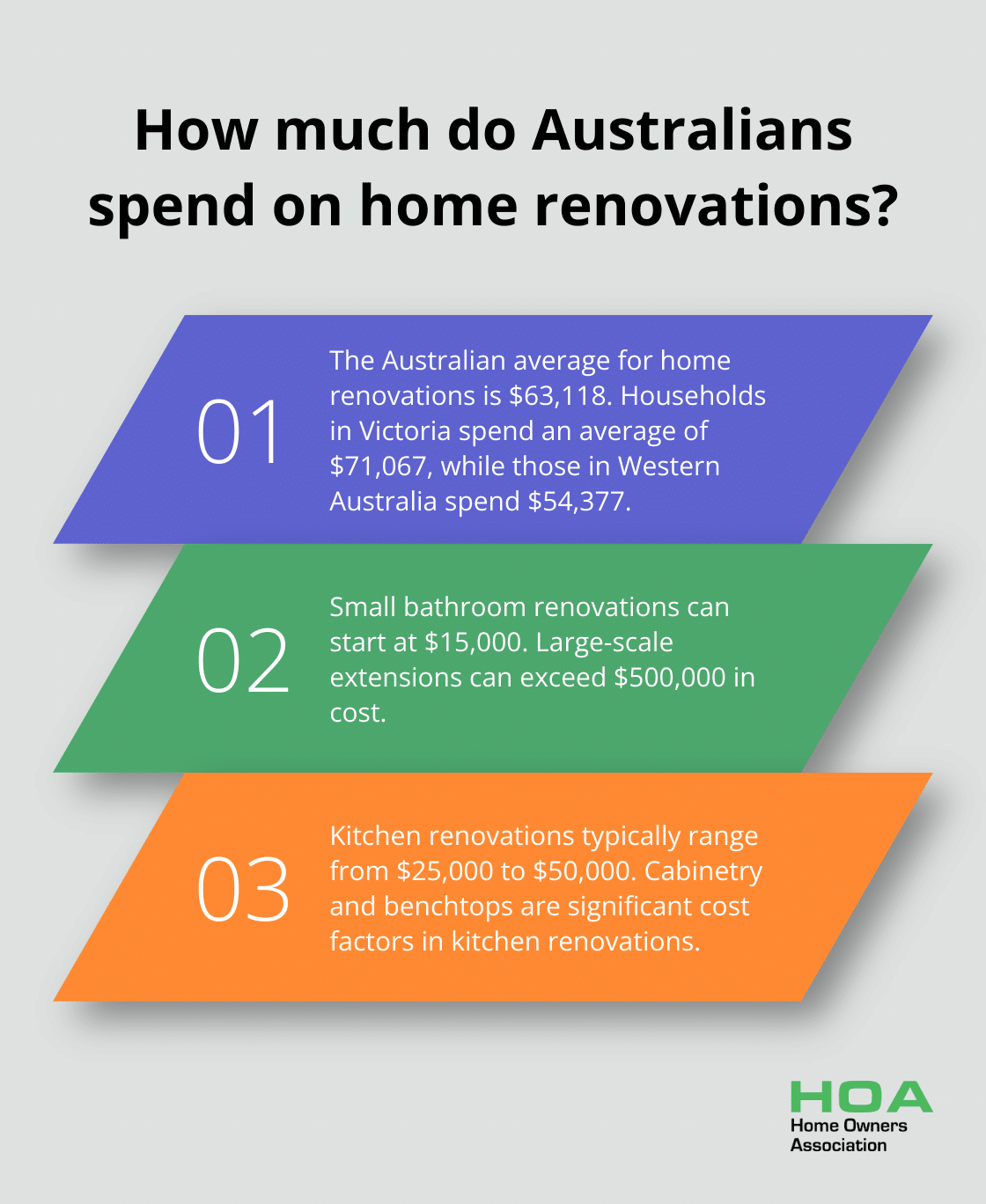
Understanding these cost drivers is the first step in planning a successful renovation. Home Owners Association offers resources to help you create a realistic budget and avoid unpleasant surprises during your home improvement journey. As we move forward, let’s break down the specific costs associated with renovating different rooms in your home.
Room-by-Room Renovation Costs
Kitchen Renovation Costs
Kitchen renovations often top the list of expensive room upgrades. Over 30% of respondents had a renovation budget between $5,000 and $15,000. Cabinetry, benchtops, and appliances consume the bulk of this expense. Custom cabinetry can cost $10,000 to $20,000, while high-end stone benchtops might require $5,000 to $10,000.
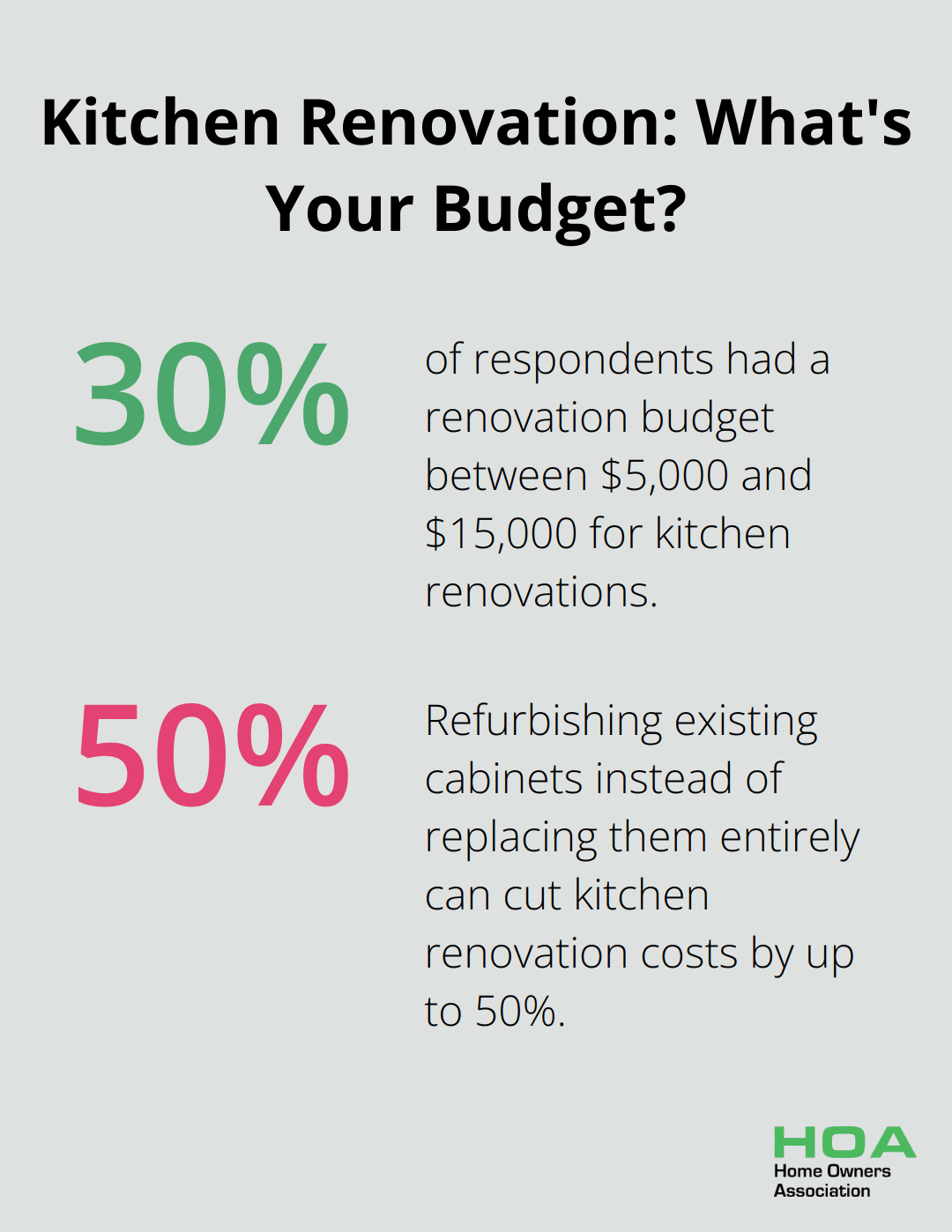
To reduce expenses, homeowners can refurbish existing cabinets instead of replacing them entirely (this can cut costs by up to 50%). Selecting mid-range appliances over top-of-the-line models can save thousands without compromising quality.
Bathroom Remodel Expenses
Bathroom renovations in Australia typically cost between $15,000 and $30,000. Tiling, plumbing fixtures, and labor account for the largest expenses. Tiling costs for simple installations with basic ceramic tiles can range from $30 to $50 per m2, including labor and materials.
Homeowners can minimize costs by maintaining the existing plumbing layout. Relocating a toilet or shower can add thousands to the budget due to additional plumbing work. Using large-format tiles requires less labor to install and can create a more spacious feel in smaller bathrooms, potentially reducing overall costs.
Living Areas and Bedrooms
Updates to living rooms and bedrooms typically cost less than kitchens or bathrooms, ranging from $10,000 to $15,000 per room. Flooring, painting, and lighting upgrades usually constitute the main expenses.
Significant savings can be achieved by refinishing existing hardwood floors instead of replacing them. This option costs about $30 to $50 per square meter, compared to $100 to $150 for new hardwood installation. For painting, a DIY approach can save up to $5,000 on labor costs for an average-sized room.
Outdoor Space Improvements
Outdoor renovations can transform your living space and add value to your property. Costs for these projects vary widely, from $2,000 for basic landscaping to $50,000 or more for extensive backyard makeovers (including features like pools or outdoor kitchens).
Simple improvements like adding a deck or patio can cost between $5,000 and $15,000, depending on size and materials. Landscaping costs typically range from $2,000 to $10,000, but can increase significantly for larger properties or complex designs.
As we move forward to discuss cost-saving strategies for your renovation project, it’s important to note that while DIY can save money on some tasks, complex work (such as electrical installations) should always be performed by licensed professionals to ensure safety and compliance with local regulations.
Smart Savings for Your Home Renovation
Plan Meticulously and Set a Realistic Budget
Create a detailed plan and set a realistic budget before you start any renovation work. Research current market prices for materials and labor in your area. The Australian Bureau of Statistics reports that building construction prices increased 0.4% in the last quarter and 4.3% over the past year. Include these increases in your budget calculations. Always add a contingency fund of at least 15% to cover unexpected expenses. Online renovation cost calculators can offer a solid starting point for your estimates.
Consider DIY for Simple Tasks
You can tackle many tasks yourself to save on labor costs, while complex jobs should remain with professionals. Painting is an excellent example. The average cost to hire a professional painter in Australia ranges from $35 to $45 per hour. You could save up to $5,000 on an average-sized room by doing it yourself. However, only attempt DIY if you have the necessary skills and tools.
Source Materials Wisely
Shop around for the best deals on materials. Visit salvage yards or recycling centers for unique, cost-effective items. Recycled materials can significantly reduce construction costs. Look out for end-of-season sales or clearance events at major hardware stores. Some associations offer members access to trade pricing, which can lead to substantial savings on construction and renovation materials.
Time Your Renovation Strategically
The timing of your renovation can impact costs significantly. Winter months often see a slowdown in construction, which means contractors may offer more competitive rates. Additionally, buying materials off-season can lead to savings. You can find discounts of up to 20% when you purchase air conditioning units in winter or heating systems in summer.
Invest in Long-Term Value
While cutting costs is important, it shouldn’t compromise quality. Invest in areas that add long-term value to your home, such as energy-efficient appliances. These investments can reduce utility bills and maintenance costs in the future.
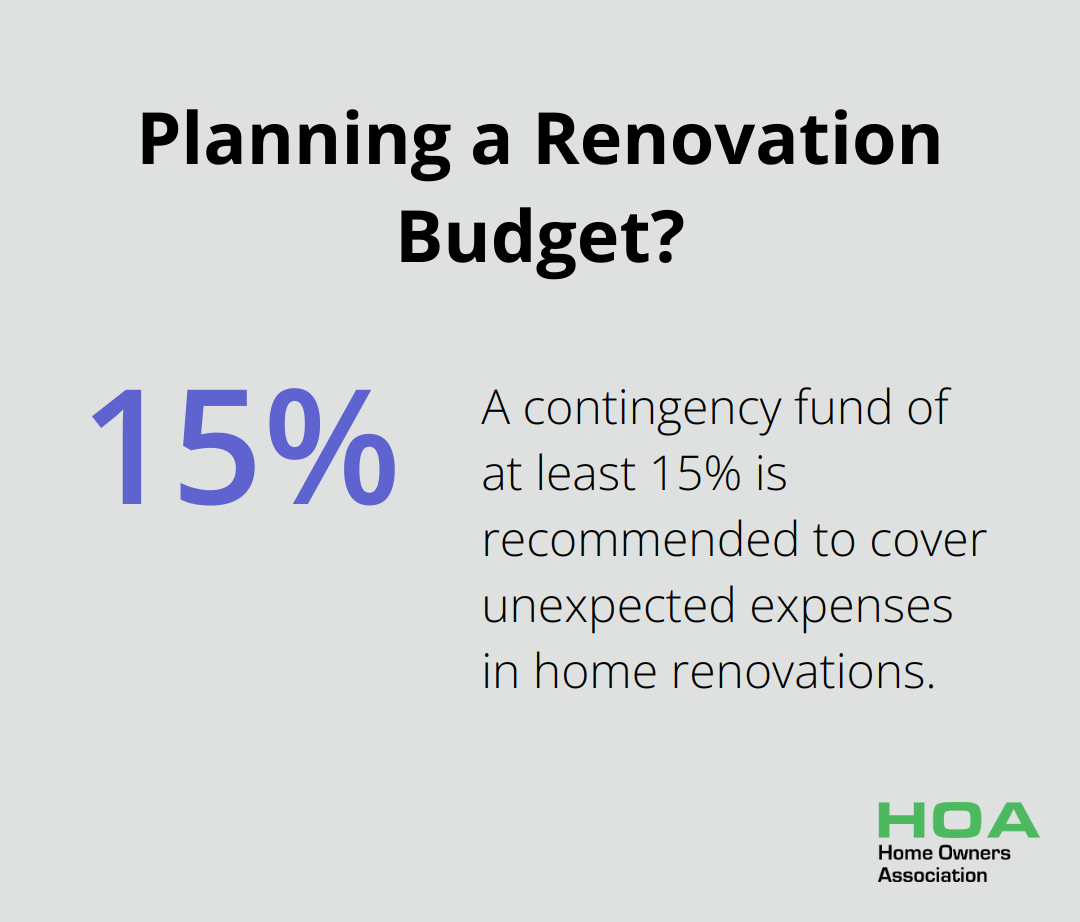
Final Thoughts
Home renovation costs depend on project scope, material quality, labor expenses, and unforeseen issues. You can reduce expenses without compromising quality through meticulous planning, DIY options for simple tasks, wise material sourcing, and strategic project timing. Investing in areas that add long-term value to your home can lead to substantial savings over time, despite higher upfront costs.
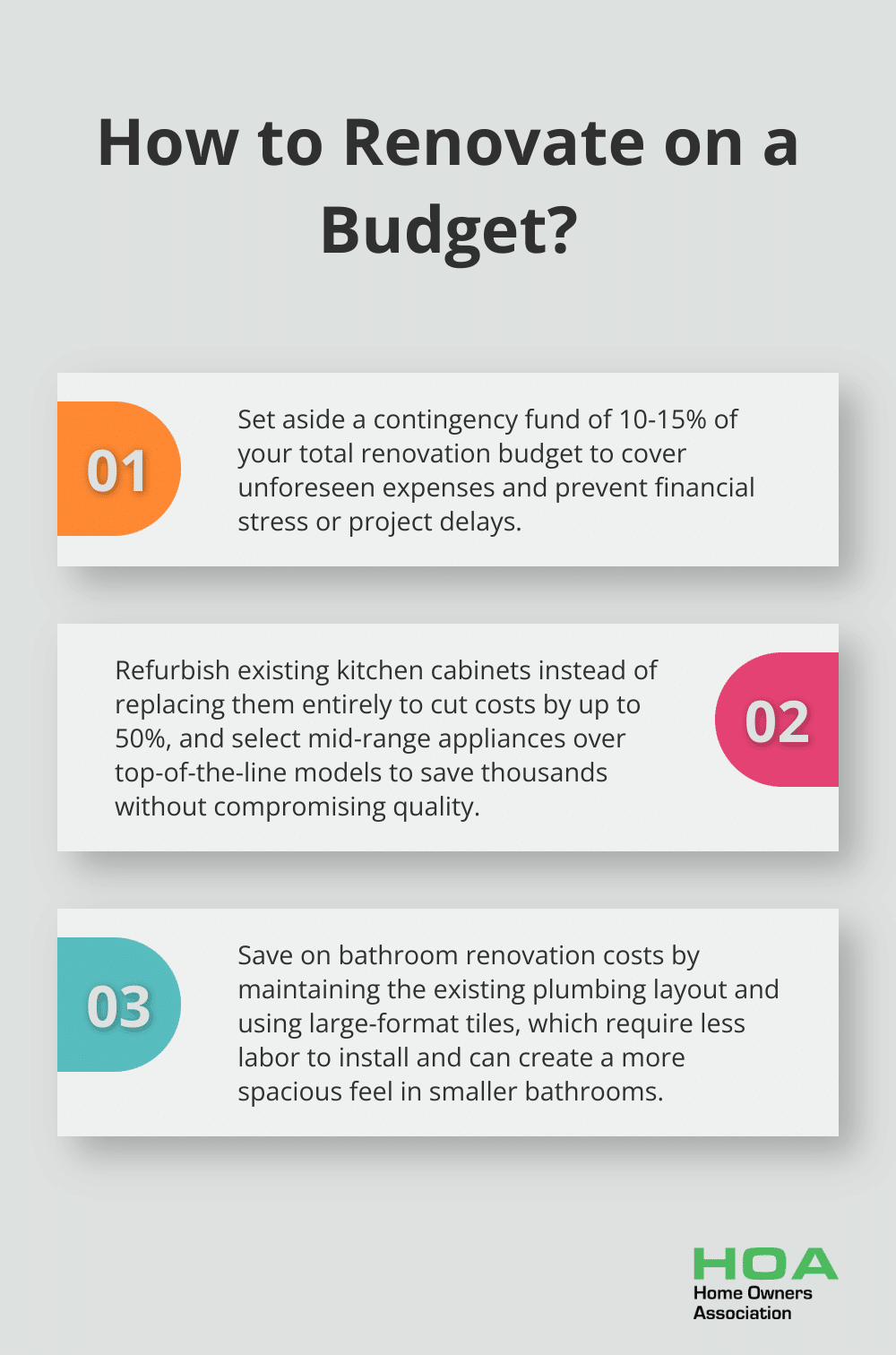
The Home Owners Association offers support for homeowners in Melbourne who want to navigate the complexities of home renovations. Our members can access trade pricing and discounts on construction and renovation materials, potentially saving thousands on their projects. We also provide expert advice, personalized guidance, and educational resources to ensure your renovation meets high quality standards and complies with local regulations.
A successful home renovation balances cost-effectiveness with quality improvements that enhance your living space and potentially increase your property’s value. You can transform your house into the home of your dreams without breaking the bank (with proper planning and execution). The Home Owners Association can help you make informed decisions throughout your renovation journey.





